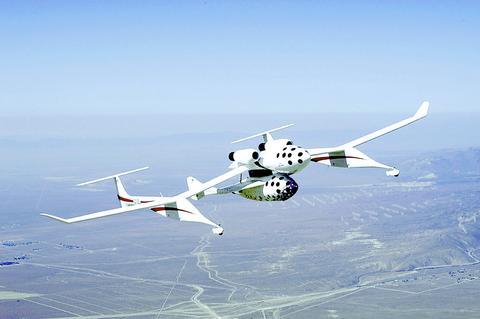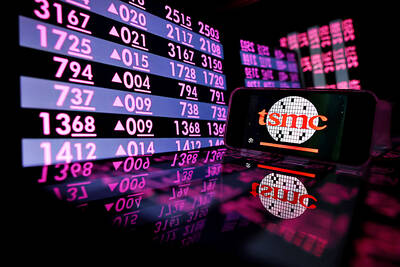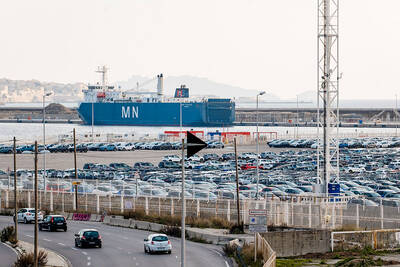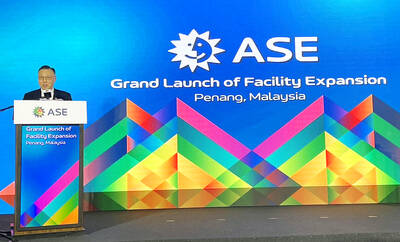Leave it to a few intrepid aviation dreamers and a team of financiers to usher in a new era in space exploration.
Tomorrow, they will make the first private attempt to launch a man into space in what they hope will be the seminal first step towards mass space travel.

PHOTO: AFP
The action will start early tomorrow from a dusty airstrip in the barren Mojave desert in southeastern California, where Burt Rutan, a legendary but maverick aviation designer will roll out SpaceShipOne for a flight that could change aviation history.
The bulbous rocket will first be carried aloft aboard a spindly white jet plane to a height of some 16km. The pair, described by technology magazine Wired as "resembling a dragonfly mating with a winged bratwurst" will then separate, and the rocketship's pilot will ignite its engine for an 80-second burn.
That will shoot SpaceShipOne to three times the speed of sound, sending it 100km above the Earth's surface. For a few seconds the unnamed pilot will feel the silence, blackness and weightlessness of space.
Then the rocket will re-enter our planet's atmosphere, diving back down to earth, before its wings move, coaxing the ship to a gentle glide back to earth, according to the team's plan.
The men behind the project are designer Rutan, who is without doubt the closest thing that avionics has to a celebrity. His designs include the "Voyager," the first plane ever to fly around the world nonstop without refuelling.
The project has been funded by Microsoft co-founder Paul Allen to the tune of US$20 million. He may get some of it back if SpaceShipOne follows up Monday's flight by winning the US$10 million Ansari X prize. This will be given to the first team to successfully launch a manned spaceship carrying the weight of three people into space, twice within a period of two weeks.
But the ultimate prize is much bigger than that. Developing a successful private space vehicle would allow them to lead the way in developing space tourism, where flights would be sold to wealthy individuals for more than US$100,000 a pop.
Even more significantly is that success would place them in a prime position for new government contracts that are at the heart of plans to reform the US space agency NASA by granting a much greater role to private enterprise.
NASA has held a complete monopoly over space exploration for the last 40 years. But as the Economist magazine noted in a recent issue, the "agency has done so in a spectacularly expensive fashion, wasting hundreds of billions on projects that fail to live up to their billing."
The space shuttle is hugely expensive, fatally unreliable, and like the International Space Station that it is meant to service, thought to be largely superfluous to the scientific reasons for space travel.
NASA's bureaucracy is notorious, and when it does hand out some of its US$15 billion budget to private firms, the work mostly goes to just two giant aerospace firms, Boeing and Lockheed Martin.
This means that creative entrepreneurs have had virtually no impact on advancing the space frontier.
Now, if all goes as planned at 6:30 tomorrow morning, a small team of designers, engineers and yes, space visionaries, are about to launch a man out of the earth's atmosphere at a price that would probably not cover the NASA coffee budget.
Rutan is renowned for coming up with brilliant and cost effective engineering solutions. In the case of SpaceshipOne his plans called for cobbling together existing technologies for a project that will become far more than just the sum of its parts.
That, say his critics, is his weakness.
"You've got to put this in the right context," said Mark Lewis, a professor of aerospace engineering at the University of Maryland.
"Taken in and of itself, it's not a big deal. They've got a small cockpit on a rocket engine. The speeds they're reaching are speeds we reached 50 years ago. The concept of dropping the craft from a carrier plane is great, but we were doing that back in the World War II era."
Others claim that the private space effort will fail at the first hurdle.
"My take on SpaceShipOne is that it won't make altitude" when it comes time to go for the X Prize, said Randa Milliron of Interorbital Systems, a Scaled Composites competitor. "It might be able to just kiss space with one person on board," Milliron said.
"But with three people? If he does it, he'll be extremely lucky."

Taiwan Semiconductor Manufacturing Co (TSMC, 台積電) yesterday said that its investment plan in Arizona is going according to schedule, following a local media report claiming that the company is planning to break ground on its third wafer fab in the US in June. In a statement, TSMC said it does not comment on market speculation, but that its investments in Arizona are proceeding well. TSMC is investing more than US$65 billion in Arizona to build three advanced wafer fabs. The first one has started production using the 4-nanometer (nm) process, while the second one would start mass production using the

A TAIWAN DEAL: TSMC is in early talks to fully operate Intel’s US semiconductor factories in a deal first raised by Trump officials, but Intel’s interest is uncertain Broadcom Inc has had informal talks with its advisers about making a bid for Intel Corp’s chip-design and marketing business, the Wall Street Journal reported, citing people familiar with the matter. Nothing has been submitted to Intel and Broadcom could decide not to pursue a deal, according to the Journal. Bloomberg News earlier reported that Taiwan Semiconductor Manufacturing Co (TSMC, 台積電) is in early talks for a controlling stake in Intel’s factories at the request of officials at US President Donald Trump’s administration, as the president looks to boost US manufacturing and maintain the country’s leadership in critical technologies. Trump officials raised the

‘SILVER LINING’: Although the news caused TSMC to fall on the local market, an analyst said that as tariffs are not set to go into effect until April, there is still time for negotiations US President Donald Trump on Tuesday said that he would likely impose tariffs on semiconductor, automobile and pharmaceutical imports of about 25 percent, with an announcement coming as soon as April 2 in a move that would represent a dramatic widening of the US leader’s trade war. “I probably will tell you that on April 2, but it’ll be in the neighborhood of 25 percent,” Trump told reporters at his Mar-a-Lago club when asked about his plan for auto tariffs. Asked about similar levies on pharmaceutical drugs and semiconductors, the president said that “it’ll be 25 percent and higher, and it’ll

CHIP BOOM: Revenue for the semiconductor industry is set to reach US$1 trillion by 2032, opening up opportunities for the chip pacakging and testing company, it said ASE Technology Holding Co (日月光投控), the world’s largest provider of outsourced semiconductor assembly and test (OSAT) services, yesterday launched a new advanced manufacturing facility in Penang, Malaysia, aiming to meet growing demand for emerging technologies such as generative artificial intelligence (AI) applications. The US$300 million facility is a critical step in expanding ASE’s global footprint, offering an alternative for customers from the US, Europe, Japan, South Korea and China to assemble and test chips outside of Taiwan amid efforts to diversify supply chains. The plant, the company’s fifth in Malaysia, is part of a strategic expansion plan that would more than triple